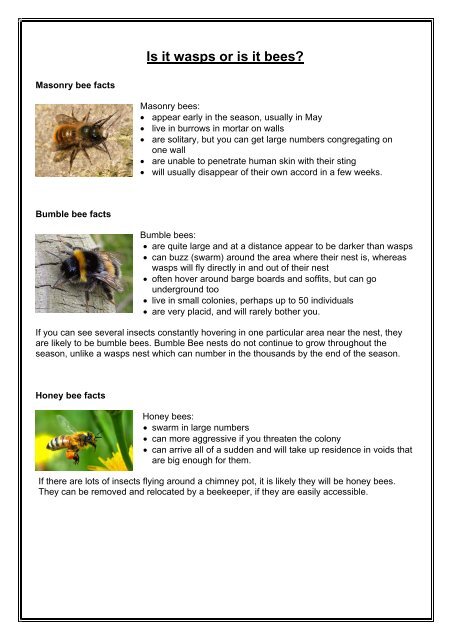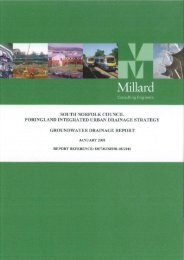have a look at this bee factsheet and see what best describes your ...
have a look at this bee factsheet and see what best describes your ...
have a look at this bee factsheet and see what best describes your ...
- No tags were found...
You also want an ePaper? Increase the reach of your titles
YUMPU automatically turns print PDFs into web optimized ePapers that Google loves.
Is it wasps or is it <strong>bee</strong>s?Masonry <strong>bee</strong> factsMasonry <strong>bee</strong>s: appear early in the season, usually in May live in burrows in mortar on walls are solitary, but you can get large numbers congreg<strong>at</strong>ing onone wall are unable to penetr<strong>at</strong>e human skin with their sting will usually disappear of their own accord in a few weeks.Bumble <strong>bee</strong> factsBumble <strong>bee</strong>s: are quite large <strong>and</strong> <strong>at</strong> a distance appear to be darker than wasps can buzz (swarm) around the area where their nest is, whereaswasps will fly directly in <strong>and</strong> out of their nest often hover around barge boards <strong>and</strong> soffits, but can gounderground too live in small colonies, perhaps up to 50 individuals are very placid, <strong>and</strong> will rarely bother you.If you can <strong>see</strong> several insects constantly hovering in one particular area near the nest, theyare likely to be bumble <strong>bee</strong>s. Bumble Bee nests do not continue to grow throughout theseason, unlike a wasps nest which can number in the thous<strong>and</strong>s by the end of the season.Honey <strong>bee</strong> factsHoney <strong>bee</strong>s: swarm in large numbers can more aggressive if you thre<strong>at</strong>en the colony can arrive all of a sudden <strong>and</strong> will take up residence in voids th<strong>at</strong>are big enough for them.If there are lots of insects flying around a chimney pot, it is likely they will be honey <strong>bee</strong>s.They can be removed <strong>and</strong> reloc<strong>at</strong>ed by a <strong>bee</strong>keeper, if they are easily accessible.
Bee inform<strong>at</strong>ion provided by the Norfolk Bee Keeping Associ<strong>at</strong>ionResponsibility for <strong>bee</strong> swarmsThe swarm is not the responsibility of the <strong>bee</strong>keeper. The swarm isthe responsibility of the person on whose property it has settled <strong>and</strong>remains so until it has <strong>bee</strong>n removed. In the event th<strong>at</strong> it cannotsafely be removed then the owner of the property must decide onwh<strong>at</strong> action he or she will take.Solitary BeesThese are sometimes referred to as mining <strong>bee</strong>s as they make small holes in the soft mortarjoints in brickwork. Holes in airbrick's, <strong>and</strong> the ends of garden canes, are also used by the<strong>bee</strong>s for egg laying.They <strong>look</strong> like honey <strong>bee</strong>s but are sometimes slightly larger <strong>and</strong> slower in their movements.They can appear in April when the we<strong>at</strong>her warms up <strong>and</strong> the eggs, which are laid theprevious spring, h<strong>at</strong>ch <strong>and</strong> adult <strong>bee</strong>s appear. The adults usually survive about 6-8 weeks<strong>and</strong> during <strong>this</strong> time they m<strong>at</strong>e <strong>and</strong>, in the holes from which they <strong>have</strong> emerged, lay the eggsfor next years <strong>bee</strong>s.Most do not sting <strong>and</strong> any th<strong>at</strong> could do not because the sting is normally too weak topenetr<strong>at</strong>e the human skin. Left alone they will not usually cause any harm. The numbersappearing <strong>at</strong> any one time is about 20/50 <strong>and</strong> unlike the honey <strong>bee</strong> they do not swarm.It is almost impossible to remove them <strong>and</strong> it is illegal to poison them. To try <strong>and</strong> stop themreappearing next year, the holes could be blocked with new mortar or some type of builder'ssealant. It is unwise to block airbricks as they are there for a purpose <strong>and</strong> should be left open.They are useful as pollin<strong>at</strong>ors, so will be <strong>see</strong>n working on flowers along with the honey <strong>bee</strong>.Bumble <strong>bee</strong>sThese are easy to identify with their round black furry bodies <strong>and</strong>football jersey liked stripes of either: yellow, orange or rustycoloured.The "Queen" emerges from hibern<strong>at</strong>ion in the spring <strong>and</strong> feeds onnectar <strong>and</strong> pollen. When the time is right she then searches out asite for the nest, <strong>this</strong> could be:disused mouse nests undergroundcompost heaps or bins (these are favourite places)unused bird nesting boxesunder garden sheds <strong>and</strong> other buildings (another favourite place)in wood pilesin thick tufts of grass.Once the site has <strong>bee</strong>n selected the queen then starts to lay eggs <strong>and</strong> from these come theyoung <strong>bee</strong>s, which are small to start with but grow quite quickly if sufficient food is available.A bumble <strong>bee</strong> nest usually never totals more than a few hundred <strong>bee</strong>s, often quite a lot less.
The nest dies out during l<strong>at</strong>e summer/early autumn, only the queen surviving until thefollowing spring.Bumble <strong>bee</strong>s are harmless <strong>and</strong> will only get agit<strong>at</strong>ed if the nest or its entrance is disturbed.Unlike honey <strong>bee</strong>s they do not swarm.Honey <strong>bee</strong>sThe honey <strong>bee</strong> is the only <strong>bee</strong> in <strong>this</strong> country which swarms <strong>and</strong> theswarming season is usually from mid-April until early August, with May<strong>and</strong> June being the months when swarming is <strong>at</strong> its gre<strong>at</strong>est.Several days before a swarm emerges from the hive "scout <strong>bee</strong>s" willfly <strong>and</strong> find various new sites for the swarm to go to <strong>and</strong> it will be oneof these sites th<strong>at</strong> the swarm will establish a new colony. It is notuncommon for people to mistake <strong>this</strong> "scouting" especially aroundchimneys, for actual swarms.A swarm will only leave the hive if the we<strong>at</strong>her is right <strong>and</strong> <strong>this</strong> is usually on a bright sunny<strong>and</strong> warm day with little or no wind, normally mid to l<strong>at</strong>e morning is a favourite time.Swarms are easy to spot as there are several thous<strong>and</strong> <strong>bee</strong>s <strong>and</strong> it will usually be as large asa football, sometimes larger <strong>and</strong> they all hang as one mass when they <strong>have</strong> settled. Solitary<strong>bee</strong>s <strong>and</strong> bumble <strong>bee</strong>s never swarm <strong>and</strong> compared with honey <strong>bee</strong>s there are only a few ofthese flying <strong>at</strong> any one time.Places where swarms settle are:branches of trees <strong>and</strong> shrubsin or on the outside of hedgesinside garden compost bins assuming there is spaceinside chimneys/central he<strong>at</strong>ing fluesin the cavity wall of a buildingon the outside wall of a high building.If the trees/hedges/compost bins are reasonably accessible the <strong>bee</strong>keeper should be able toremove the swarm without too much difficulty. It is almost impossible to remove honey <strong>bee</strong>sfrom a chimney or cavity if they <strong>have</strong> <strong>bee</strong>n there more than 2/3 days, as in th<strong>at</strong> time they will<strong>have</strong> started to build comb <strong>and</strong> establish themselves. They will probably survive until thewinter but because of lack of food or disease will die before spring. If it is necessary to destroythe <strong>bee</strong>s then <strong>this</strong> has to be done by a pest control company, <strong>bee</strong>keepers are not killers ofhoney <strong>bee</strong>s.



![List of outstanding appeals against planning decisions [PDF, 30 Kb]](https://img.yumpu.com/51294693/1/190x135/list-of-outstanding-appeals-against-planning-decisions-pdf-30-kb.jpg?quality=85)



![Brown bin calendar - week 2 [PDF] - South Norfolk Council](https://img.yumpu.com/49352110/1/184x260/brown-bin-calendar-week-2-pdf-south-norfolk-council.jpg?quality=85)



![Link magazine, Spring 2008 [PDF, 4,450k] - South Norfolk Council](https://img.yumpu.com/43994858/1/184x260/link-magazine-spring-2008-pdf-4450k-south-norfolk-council.jpg?quality=85)

![South Norfolk Council Volunteering Opportunities [PDF]](https://img.yumpu.com/42079564/1/184x260/south-norfolk-council-volunteering-opportunities-pdf.jpg?quality=85)
![Tiffey Valley Guide [PDF, 1,450k] - South Norfolk Council](https://img.yumpu.com/41615145/1/124x260/tiffey-valley-guide-pdf-1450k-south-norfolk-council.jpg?quality=85)
![Queen's Diamond Jubilee Fund [PDF] - South Norfolk Council](https://img.yumpu.com/41088331/1/184x260/queens-diamond-jubilee-fund-pdf-south-norfolk-council.jpg?quality=85)
